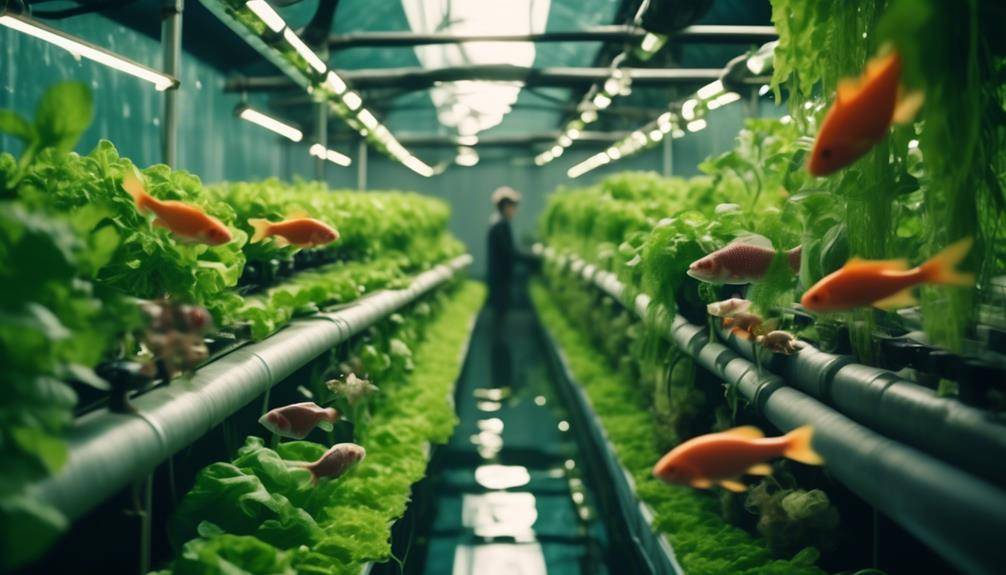The Emerging Efficiency Of Aquaponics In Urban Farming

Efficiency Of Aquaponics In Urban Farming; Imagine walking through a bustling city, surrounded by towering skyscrapers and concrete jungles. Amidst this urban chaos, there is a hidden oasis – a rooftop garden flourishing with life. In this microcosm of nature, aquaponics emerges as a beacon of efficiency in urban farming. By seamlessly integrating aquaculture and hydroponics, this innovative system offers a multitude of benefits. From maximizing space utilization to reducing water consumption and achieving year-round production, the potential of aquaponics in urban farming is boundless. But what makes it truly remarkable? Let’s explore further and uncover the untapped potential of this captivating agricultural technique.
Maximized Use of Space
To maximize the use of space in urban farming, it is essential to employ efficient techniques and innovative systems such as aquaponics. Aquaponics is a sustainable method that combines hydroponics and aquaculture, allowing for the cultivation of plants and the rearing of aquatic animals in a symbiotic environment. This system offers several advantages, particularly in terms of space optimization.
One key aspect of aquaponics is its suitability for vertical farming. By utilizing vertical space, aquaponics systems can maximize productivity in urban areas where land is limited. Vertical farming involves stacking multiple layers of plants vertically, allowing for a higher plant density within a smaller footprint. In an aquaponics setup, plants are typically grown in vertical towers or racks, which take advantage of unused vertical space. This vertical arrangement increases the overall yield per square meter and allows for the cultivation of a larger variety of crops.
Furthermore, aquaponics eliminates the need for soil, which further optimizes space utilization. Hydroponic systems, which are commonly used in aquaponics, provide plants with the necessary nutrients through a water-based solution. This eliminates the need for traditional soil-based agriculture, where large amounts of land are required for planting. Without soil, aquaponics systems can be set up in smaller areas and can even be implemented indoors, making it possible to grow crops year-round regardless of weather conditions.
Sustainable Resource Management
What are the key principles of sustainable resource management in aquaponics?
Aquaponics, as a sustainable farming method, prioritizes efficient resource management. Waste reduction and community engagement are two key principles in achieving sustainable resource management in aquaponics.
- Waste Reduction: In aquaponics, waste from fish is converted into nutrients for plants, creating a closed-loop system. By utilizing the waste produced by fish, aquaponics minimizes the need for external fertilizers and reduces waste disposal. This not only prevents environmental pollution but also saves resources and reduces costs.
- Community Engagement: Sustainable resource management in aquaponics involves engaging and involving the community. This can be through educational programs, workshops, or partnerships with local organizations. By educating the community about aquaponics and its benefits, there is an opportunity to foster a sense of ownership and responsibility towards sustainable farming practices. Involving the community in the process can also lead to increased support, collaboration, and knowledge sharing.
- Resource Optimization: Aquaponics maximizes resource utilization by minimizing water usage and optimizing energy consumption. The recirculating system in aquaponics allows for water conservation, as water is continuously reused and recycled. Additionally, energy-efficient practices, such as using energy-saving LED lights and efficient pump systems, can further reduce energy consumption. By optimizing resources, aquaponics ensures efficient and sustainable use of limited resources.
Sustainable resource management in aquaponics involves waste reduction, community engagement, and resource optimization. By implementing these principles, aquaponics not only minimizes environmental impact but also creates a more resilient and economically viable farming system. With continued research and technological advancements, aquaponics has the potential to revolutionize urban farming and contribute to a more sustainable future.
Increased Crop Yields
Increased crop yields are a fundamental goal in aquaponics, as it aims to optimize plant growth and productivity within a closed-loop system. One of the key factors contributing to the increased crop yields in aquaponics is the improved nutrient balance. In traditional farming, the availability and absorption of nutrients by plants can be limited due to soil conditions and nutrient loss. However, in aquaponics, the fish waste serves as a nutrient-rich solution for the plants, providing them with a constant supply of essential minerals and elements. This optimized nutrient balance allows plants to grow faster and healthier, leading to higher crop yields.
Research has shown that aquaponics systems can significantly enhance plant growth compared to traditional soil-based farming methods. Studies have demonstrated that aquaponics can result in up to three times higher crop yields for certain plant species, such as lettuce and tomatoes. This increased productivity is mainly attributed to the improved nutrient availability and uptake by plants in an aquaponics system.
Furthermore, the closed-loop nature of aquaponics ensures that the plants receive a consistent and balanced supply of nutrients throughout their growth cycle. This steady nutrient availability eliminates the need for excessive fertilization or the risk of nutrient deficiencies, which can hinder plant growth and reduce crop yields. The plants in an aquaponics system also benefit from the constant water circulation, which helps in the efficient distribution of nutrients and oxygen to the root zone, further enhancing their growth and productivity.
Reduced Water Consumption
The implementation of aquaponics systems has been found to significantly reduce water consumption in comparison to traditional farming methods. This is due to the unique combination of aquaculture and hydroponics, where fish waste is used as a nutrient source for plants, and the plants, in turn, filter the water for the fish. By utilizing this closed-loop system, aquaponics minimizes the need for excessive water usage, making it a sustainable and efficient alternative for urban farming.
The reduced water consumption in aquaponics is primarily attributed to the following factors:
- Recirculation of water: In aquaponics, water is continuously recirculated within the system, rather than being lost through traditional irrigation methods. This recirculation process allows for the conservation of water resources, as it significantly reduces the amount of water required for crop growth.
- Alternative irrigation methods: Aquaponics employs alternative irrigation methods such as drip irrigation or nutrient film technique (NFT), which deliver water and nutrients directly to the plant roots in a controlled manner. This targeted approach ensures that water is used efficiently, preventing wastage that often occurs in conventional farming practices.
- Economic benefits: The reduced water consumption in aquaponics translates into economic benefits for farmers. By minimizing the water needed for crop production, aquaponics reduces water-related costs, such as pumping and irrigation expenses. Additionally, the closed-loop system minimizes the need for fertilizers and pesticides, further reducing input costs.
Year-Round Production
With the reduced water consumption and sustainable practices of aquaponics, urban farmers can achieve year-round production of crops. This is made possible through the use of vertical farming and greenhouse technology, which provide optimal growing conditions regardless of the external environment.
Vertical farming is a method that involves cultivating plants in stacked layers, using a variety of techniques such as hydroponics or aeroponics. By utilizing vertical space, farmers can maximize their crop yield within a limited area. In aquaponics, this means that fish tanks can be stacked vertically, with the nutrient-rich water flowing downwards to nourish the plants. This vertical arrangement allows for a higher density of crops, enabling farmers to produce more food in a smaller footprint.
Greenhouse technology plays a crucial role in enabling year-round production in aquaponics. Greenhouses provide a controlled environment, allowing farmers to regulate temperature, humidity, and light levels. This is particularly advantageous in urban areas where the external climate may be unsuitable for year-round cultivation. By creating a stable microclimate, greenhouses ensure consistent crop growth and protect plants from adverse weather conditions, pests, and diseases.
Furthermore, greenhouse technology allows for the use of supplemental lighting, which extends the daily photoperiod and boosts plant growth. This is especially beneficial during the winter months when natural sunlight is limited. By providing the necessary light spectrum and intensity, farmers can mimic ideal growing conditions and ensure continuous crop production throughout the year.
Efficiency Of Aquaponics In Urban Farming; Frequently Asked Questions
What Are the Main Challenges in Maximizing Space Usage in Urban Aquaponics Systems?
You face challenges when maximizing space efficiency in urban aquaponics systems. Vertical farming techniques can help optimize space usage by utilizing vertical space and growing plants in stacked layers.
How Does Aquaponics Contribute to Sustainable Resource Management in Urban Farming?
Aquaponics contributes significantly to sustainable resource management in urban farming. It combines aquaculture and hydroponics to efficiently use water and nutrients, reducing waste and environmental impact. Additionally, it has proven economic viability in urban areas.
Can Aquaponics Really Increase Crop Yields Compared to Traditional Farming Methods?
Aquaponics can indeed increase crop yields when compared to traditional farming methods. A comparison study showed that aquaponics achieved greater efficiency in resource utilization, resulting in higher yields and reduced environmental impact.
How Does Aquaponics Help in Reducing Water Consumption in Urban Farming?
Aquaponics reduces water usage in urban farming by recycling and reusing water. By creating a closed-loop system where fish waste provides nutrients for plants, water is conserved and used efficiently, increasing overall urban farming efficiency.
What Are the Key Factors That Enable Year-Round Production in Aquaponics Systems?
To achieve year-round production in aquaponics systems, key factors include controlling temperature and light, optimizing nutrient levels, managing fish and plant populations, and ensuring efficient water circulation and filtration.
Conclusion
In conclusion, the efficiency of aquaponics in urban farming is evident through its maximized use of space, sustainable resource management, increased crop yields, reduced water consumption, and year-round production. This research-based evidence highlights the potential of aquaponics as a viable solution for urban areas. By utilizing this innovative system, urban farmers can optimize their resources, increase productivity, and contribute to a more sustainable and productive food production system.








